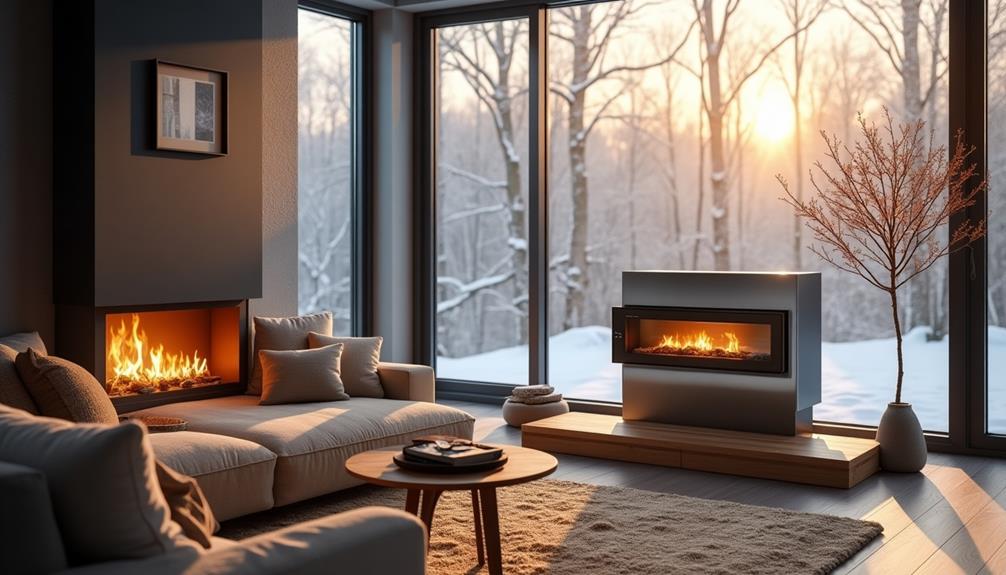When it comes to staying warm this winter, you might be wondering which heating system offers the best energy efficiency. With options like high-efficiency furnaces, heat pumps, and radiant floor heating, it's essential to consider not just the initial cost but also the long-term savings on your utility bills. You'll find that some systems might suit your needs better than others, especially when you factor in advanced technologies like smart thermostats. But before making a decision, let's explore the key benefits and features of each option to determine what could work best for you.
Understanding Energy Efficiency Ratings
When considering a new heating system, understanding energy efficiency ratings is crucial. These ratings help you gauge how well a heating system converts energy into heat, which directly impacts your energy bills and environmental footprint.
Familiarizing yourself with energy efficiency standards is essential for making an informed decision.
There are various rating systems you should know about. The Seasonal Energy Efficiency Ratio (SEER) and the Annual Fuel Utilization Efficiency (AFUE) are two key metrics you'll encounter. SEER measures cooling efficiency, while AFUE indicates how efficiently a furnace converts fuel into heat. A higher rating in either system suggests better efficiency.
Additionally, look for ENERGY STAR labels, which signify that a system meets strict efficiency standards set by the U.S. Environmental Protection Agency. These systems can save you money on energy costs and reduce greenhouse gas emissions.
When you compare heating systems, consider these ratings carefully. They provide a clear view of how each option can perform in real-world conditions, ensuring you invest in a heating system that's not just effective but also energy-efficient.
Benefits of Smart Thermostats
Smart thermostats offer you enhanced temperature control, allowing you to set and adjust your home's climate with ease.
You can also monitor your energy usage in real-time, helping you identify areas where you can save.
Plus, with remote accessibility features, you can manage your heating from anywhere, ensuring comfort and efficiency at all times.
Enhanced Temperature Control
Transforming your home's heating efficiency, smart thermostats offer significant benefits for enhanced temperature control. They provide precise temperature regulation, allowing you to set your desired comfort level with ease.
With advanced features, these devices learn your preferences and adjust the heating schedule accordingly, ensuring your home stays cozy when you need it most.
Imagine coming home to a perfectly warm environment without wasting energy while you're away. Smart thermostats can optimize your home's climate control by adapting to your daily routines.
You can even control the temperature remotely through your smartphone, giving you the freedom to make adjustments from anywhere.
Additionally, many smart thermostats can detect when you're home or away, automatically shifting to energy-saving modes when you're not around.
This means you won't be heating an empty house, which can lead to significant savings on your energy bills.
Energy Usage Monitoring
One of the standout features of modern thermostats is their ability to monitor energy usage. This capability lets you gain valuable insights into your home's energy consumption trends, helping you make informed decisions about your heating system.
By using smart thermostats equipped with advanced monitoring tools, you can track how much energy your heating system consumes over time.
These monitoring tools provide real-time data, allowing you to see daily, weekly, or monthly usage patterns. You'll quickly identify inefficiencies or unusual spikes in energy consumption, which can be crucial for pinpointing potential issues. For instance, if you notice a sudden increase in energy use, it could signal that your heating system needs maintenance or that your home isn't as insulated as it should be.
Additionally, many smart thermostats offer personalized recommendations based on your usage patterns, helping you optimize your heating settings.
Remote Accessibility Features
Having insights into your energy usage is just the beginning of what modern heating technology can offer. With smart thermostats, you gain the power of remote accessibility features that make managing your home's heating more convenient than ever.
Imagine being able to adjust your thermostat from anywhere using your smartphone. Whether you're at work, on vacation, or just lounging on the couch, remote monitoring lets you control your heating system with a few taps.
These devices often integrate seamlessly with your smart home setup, allowing you to create schedules and automate your heating based on your lifestyle. You can set your system to warm up your home just before you arrive, ensuring comfort while minimizing energy waste.
Plus, many smart thermostats provide alerts when your heating system isn't operating efficiently, empowering you to take action before issues escalate.
Incorporating these features into your home not only offers convenience but also helps you save on energy costs. With remote accessibility, you're in control, making it easier to maintain an energy-efficient home throughout the winter months.
High-Efficiency Furnaces
When it comes to heating your home efficiently, high-efficiency furnaces stand out as a smart choice. They convert a greater percentage of fuel into usable heat, which means you'll spend less on energy bills while keeping your space comfortable.
These furnaces typically achieve an Annual Fuel Utilization Efficiency (AFUE) rating of 90% or higher, making them a top contender for energy-savvy homeowners.
To get the most out of your high-efficiency furnace, it's essential to follow some furnace maintenance tips. Regular filter changes, annual inspections, and cleaning of the ductwork can enhance performance and longevity.
Additionally, proper sizing is crucial; an incorrect furnace size can lead to inefficiencies. For this, you'll want to perform a furnace size calculation based on your home's square footage, insulation levels, and climate.
Innovations in Heat Pumps
As homeowners seek even more ways to enhance energy efficiency, innovations in heat pumps are gaining attention. These systems have evolved significantly, employing geothermal systems that harness the Earth's thermal energy for efficient heating.
Hybrid models combine traditional heating methods with heat pumps, optimizing energy use and reducing costs. The introduction of innovative refrigerants improves efficiency and lowers environmental impact, making heat pumps even more eco-friendly.
Advanced compressors and variable speed technology allow these systems to adjust their output based on demand, ensuring consistent comfort while minimizing energy waste.
Noise reduction is another key innovation, as modern heat pumps operate quietly, making them suitable for any home environment. Additionally, zoning systems enable you to control the temperature in different areas, further enhancing comfort and efficiency.
Energy recovery technology captures waste heat and repurposes it, maximizing overall performance. With these advancements, heat pumps not only provide sustainable heating solutions but also contribute significantly to energy savings.
Radiant Floor Heating Systems
Radiant floor heating systems offer several advantages, including consistent warmth and energy efficiency.
When considering installation, you'll want to think about your home's layout and the types of flooring you have.
Plus, a cost-effectiveness analysis can help you determine if this heating method fits your budget and long-term savings goals.
Advantages of Radiant Heating
Many homeowners are discovering the numerous advantages of radiant heating systems, particularly radiant floor heating. One of the biggest benefits you'll notice is the exceptional comfort it provides. Unlike traditional heating methods that rely on forced air, radiant heating warms your home from the ground up, ensuring even heat distribution. You won't have to deal with cold spots or drafts, making your living space more enjoyable during the chilly winter months.
Another advantage is the reduced maintenance requirements. Radiant floor heating systems are typically durable and require minimal upkeep compared to conventional systems. With fewer moving parts, there's less that can go wrong, which means you can spend less time worrying about repairs and more time enjoying your cozy environment.
Additionally, radiant heating is energy-efficient. By using lower temperature water to heat your floors, you can save on energy bills while still maintaining a comfortable atmosphere in your home.
Installation Considerations
When considering the installation of radiant floor heating systems, it's crucial to evaluate several key factors.
First, you'll want to conduct a ductwork assessment. Since radiant systems don't rely on ducts, understanding the existing ductwork in your home helps determine if it can be repurposed or if modifications are necessary. If your home has forced-air heating, you may need to seal or remove ducts to ensure efficiency.
Next, an insulation evaluation is essential. Good insulation enhances the performance of radiant heating by minimizing heat loss. Check your floors, walls, and ceilings for any gaps or weaknesses in insulation. Properly insulated spaces won't only improve comfort but also reduce energy consumption.
Additionally, consider your flooring type. Some materials, like tile, conduct heat better than carpet, which can insulate and prevent warmth from rising effectively.
Lastly, think about the layout of your heating system. A well-planned installation ensures even heat distribution throughout your space.
Cost-Effectiveness Analysis
Choosing a heating system can feel overwhelming, but analyzing the cost-effectiveness of radiant floor heating systems can simplify the decision. When you conduct a thorough cost comparison, you'll find that although the initial installation may be higher than traditional systems, the long-term savings often outweigh these upfront costs.
Radiant floor heating operates efficiently, providing even heat while reducing energy consumption, which can lead to significant savings on your utility bills. Moreover, once installed, these systems require minimal maintenance, further enhancing their cost-effectiveness.
Over time, the energy efficiency translates into lower heating costs, making radiant floor heating an appealing option for homeowners looking to save money in the long run.
You should also consider the comfort level these systems provide. With radiant heating, the warmth rises from the floor, creating a cozy atmosphere that can improve your overall quality of life.
Using Solar Heating Solutions
Solar heating solutions offer a sustainable and cost-effective way to keep your home warm while reducing energy bills. By integrating solar panels, you can harness the sun's energy, turning it into usable heat for your space. This method not only cuts down on reliance on fossil fuels but also minimizes your carbon footprint.
Incorporating passive solar design into your home can further enhance energy efficiency. This approach maximizes natural sunlight through strategic window placement and thermal mass materials, allowing your home to gather and store heat during the day. As a result, you can enjoy a comfortable indoor environment without over-relying on mechanical heating systems.
When considering solar heating solutions, think about how much sunlight your home receives and the layout of your space. Choosing the right solar panel integration and passive design elements can make a significant difference in performance.
These systems often come with lower maintenance costs, providing long-term savings. With the right setup, you'll not only keep your home cozy but also contribute to a more sustainable future. Embrace solar heating and start enjoying the benefits today!
Tips for Maximizing Efficiency
Maximizing efficiency in your heating system can save you money and enhance comfort throughout your home.
Start by conducting a thorough inspection of your insulation. Insulation upgrades can significantly reduce heat loss, keeping your home warmer without overworking your heating system. Pay special attention to areas like attics, basements, and crawl spaces, where insulation is often lacking.
In addition to insulation, implementing weatherization techniques can further boost your system's performance. Seal any gaps or cracks around windows, doors, and vents to prevent drafts. Use caulk or weatherstripping to ensure a tight seal. This simple step can drastically improve your heating efficiency.
Don't forget about regular maintenance. Schedule annual check-ups for your heating system to ensure it's running at peak performance. Clean or replace filters regularly to maintain airflow.







